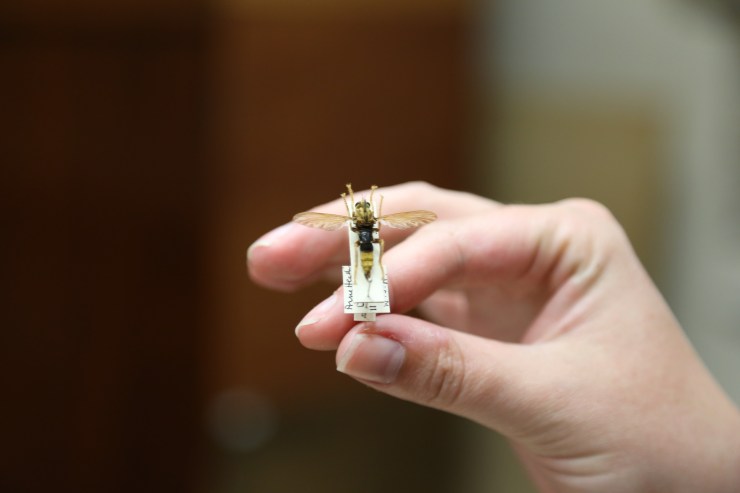To celebrate National Insect Week 2016 we thought we would introduce you to the custodians of the Hope Entomology Collection here at the Museum. Our insect collection is made up of a whopping 6 million specimens, so our resident entomologists definitely have their work cut out. However, they have taken a little time out to tell us all about their specialisms and why their favourite insects are the best.
Zoë Simmons – Life Collections

I have many favourites in the collections that I look after- insects demonstrate an immense diversity of form and behaviour. So much so in fact that I defy anyone that says that there is not one thing that they do not find interesting among the almost one million species described to date.
One of the groups that I often find myself returning to though is the Asilidae or Robber Flies. This is a group of predatory flies that feed on a wide range of insect species. Many species sport heavily bristled moustaches, which are thought to protect their faces as they feed but have the added bonus of making the on-trend hipster insect of the moment.

As is common with predators they have exceedingly good eyesight and will sit, perched until they spot movement, at which point they will strike at the prey item in the air.
The legs are furnished with long spines that help hold the prey and the mouthparts have evolved into a hardened beak-like structure which can stab through even the tough exoskeleton of beetles. Entomologists who specialise in catching Asilids have to be wary as these flies are not afraid to use this to their advantage.

As it happens, the largest and most striking species of fly in Britain is the Hornet Robber Fly, or as it is more commonly known, Asilus crabroniformis. Superficially, its appearance closely resembles that of a hornet. Seen from a distance it is easy to see how the two species may be confused by the casual observer (pro-tip: look for the antennae. Hornets have long, obvious yellow-brown antennae whereas those of the Robber Fly are dark and small), so much so in fact that the species name for the Robber Fly crabroniformis, translates as ‘hornet-form’. This mimicry of a species that is able to sting affords the Robber Fly a level of protection. It does not have a sting itself but the bluff works well.

Also of interest, and linked to the next post by Darren Mann, is the fact that this species is one of the top predators of dung beetles. The females require dung from a herbivore such as a horse or cow to lay their eggs in. As a consequence adults can often be found hanging out in fields near to piles of dung, hoping to meet the mustachioed mate(s) of their dreams, whilst snacking on dung beetles that fly in to start their own dung-related romance story. The presence of this Robber Fly species is often indicative of the quality of the dung and its associated beetle fauna, and as such should be greeted with warmth and a hearty ‘hurrah’ if spotted for it means that the habitat is healthy.


It would be helpful to show a closeup photo of the fly to see the mustache. This might better illustrate the story.
Hello, yes good idea thank you. Have now added a photo of one in the wild by one of our team. You can see the moustache in profile.
This image I put on facebook last year shows the mustache rather well: https://www.facebook.com/photo.php?fbid=10205932243958760&set=pb.1039260444.-2207520000.1466439086.&type=3&theater
Thanks very much for your post – it is a great shot! We have put a photo up to show the moustache in profile.